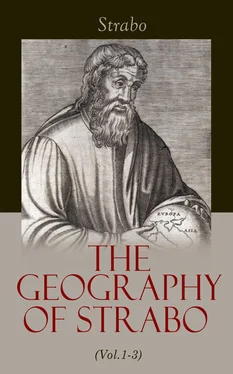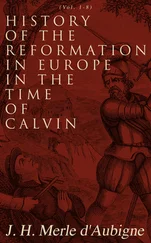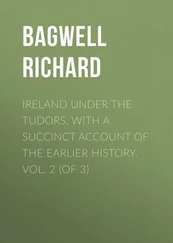Strabo - The Geography of Strabo (Vol.1-3)
Здесь есть возможность читать онлайн «Strabo - The Geography of Strabo (Vol.1-3)» — ознакомительный отрывок электронной книги совершенно бесплатно, а после прочтения отрывка купить полную версию. В некоторых случаях можно слушать аудио, скачать через торрент в формате fb2 и присутствует краткое содержание. Жанр: unrecognised, на английском языке. Описание произведения, (предисловие) а так же отзывы посетителей доступны на портале библиотеки ЛибКат.
- Название:The Geography of Strabo (Vol.1-3)
- Автор:
- Жанр:
- Год:неизвестен
- ISBN:нет данных
- Рейтинг книги:3 / 5. Голосов: 1
-
Избранное:Добавить в избранное
- Отзывы:
-
Ваша оценка:
- 60
- 1
- 2
- 3
- 4
- 5
The Geography of Strabo (Vol.1-3): краткое содержание, описание и аннотация
Предлагаем к чтению аннотацию, описание, краткое содержание или предисловие (зависит от того, что написал сам автор книги «The Geography of Strabo (Vol.1-3)»). Если вы не нашли необходимую информацию о книге — напишите в комментариях, мы постараемся отыскать её.
The Geography of Strabo (Vol.1-3) — читать онлайн ознакомительный отрывок
Ниже представлен текст книги, разбитый по страницам. Система сохранения места последней прочитанной страницы, позволяет с удобством читать онлайн бесплатно книгу «The Geography of Strabo (Vol.1-3)», без необходимости каждый раз заново искать на чём Вы остановились. Поставьте закладку, и сможете в любой момент перейти на страницу, на которой закончили чтение.
Интервал:
Закладка:
7. Between this coast, where the Guadalquiver and Guadiana discharge themselves, and the extremities of Maurusia, the Atlantic Ocean forms the strait at the Pillars [of Hercules] by which it is connected with the Mediterranean. Here is situated Calpe, 1002the mountain of the Iberians who are denominated Bastetani, by others Bastuli. Its circumference is not large, but it is so high and steep as to resemble an island in the distance. Sailing from the Mediterranean into the Atlantic, it is left on the right hand. At a distance of 40 stadia from this [mountain] is the considerable and ancient city of Carteia, formerly a marine arsenal of the Iberians. Some assert that it was founded by Hercules; of this number is Timosthenes, 1003who tells us it was anciently called Heraclæa, and that vast walls and ship-sheds are still shown.
8. Next to these is Mellaria, 1004where they make salted provisions. After this the city and river 1005of Belo. Here the merchandise and salted provisions for Tingis in Maurusia are principally shipped. There was a city named Zelis 1006near to Tingis, but the Romans transferred it to the opposite coast [of Spain], and having placed there in addition some of the inhabitants of Tingis, and sent over also some of their own people, they then gave to the city the name of Julia Joza. 1007Beyond this is Gadeira, 1008an island separated from Turdetania by a narrow strait, and distant from Calpe about 750 stadia, or, as others say, 800. This island has nothing to distinguish it above others, but owing to the boldness of its people in their expeditions by sea, and their friendship with the Romans, has attained to that pitch of good fortune, that although situated at the farthest extremities of the earth, it possesses a greater celebrity than any other island. But we will describe it when we come to speak of the other islands.
9. Next after [Cadiz] is the port of Menestheus, 1009and the estuary near to Asta and Nebrissa. 1010These estuaries are valleys filled by the sea during its flood-tides, up which you may sail into the interior, and to the cities built on them, in the same way as you sail up a river. Immediately after are the two outlets of the Guadalquiver. 1011The island embraced by these mouths has a coast of a hundred stadia, or rather more according to others. Hereabouts is the Oracle of Menestheus, 1012and the tower of Cæpio, 1013built upon a rock and washed on all sides by the sea. This is an admirable work, resembling the Pharos, and constructed for the safety of vessels. For the mud carried out by the river forms shallows, and sunken rocks are also scattered before it, so that a beacon was greatly needed. Thence sailing up the river is the city of Ebura, 1014and the temple of Phosphorus, 1015which they call Lux Dubia . 1016You then pass up the other estuaries; and after these the river Guadiana, which has also two mouths, 1017up either of which you may sail. Lastly, beyond is the Sacred Promontory, 1018distant from Gadeira 1019less than 2000 stadia. Some say that from the Sacred Promontory to the mouth of the Guadiana there are 60 miles; thence to the mouth of the Guadalquiver 100; and from this latter place to Gadeira 70.
[Pg 212]
CAS. 141
CHAPTER II.
Table of Contents
1. Turdetania lies above the coast on this side the Guadiana, 1020and is intersected by the river Guadalquiver. 1021It is bounded on the west and north by the river Guadiana; on the east by certain of the Carpetani and the Oretani; on the south by those of the Bastetani who inhabit the narrow slip of coast between Calpe and Gadeira, and by the sea beyond as far as the Guadiana. The Bastetani whom I have mentioned, together with the people on the other side the Guadiana, and many of the places adjacent, belong to Turdetania. The size of this country in its length and breadth does not exceed two thousand stadia, still it contains a vast number of towns; two hundred, it is said. Those best known are situated on the rivers, estuaries, and sea; but the two which have acquired the greatest name and importance are, Corduba, founded by Marcellus, 1022and the city of the Gaditanians. 1023The latter for its naval importance, and its alliance with the Romans; and the former on account of its fertility and extent, a considerable portion of the Guadalquiver flowing by it; in addition to this it has been from its commencement inhabited by picked men, whether natives or Romans; and it was the first colony planted by the Romans in these parts.
After this city and that of the Gaditanians, Hispalis 1024is the most noted. This also is a Roman colony. Commerce is still carried on here, although at the present moment the city of Bætis 1025though not so finely built, is outshining it, on account of the honour it has received from the soldiers of Cæsar taking up their quarters there.
2. After these are Italica, 1026and Ilipa, 1027situated on the Guadalquiver; farther on are Astygis, 1028Carmo, 1029and Obulco; and besides these Munda, 1030Ategua, Urso, 1031Tukkis, 1032Julia, 1033and Ægua, where the sons of Pompey were defeated. None of these places are far from Corduba. Munda is in some sort regarded as the metropolis of the whole district. This place is distant from Carteia 1400 1034stadia, and it was here that Cnæus fled after his defeat, and sailing thence landed on a rocky height overlooking the sea, where he was murdered. His brother Sextus, having escaped from Corduba, after carrying on the war for a short time in Spain, caused a revolt in Sicily. Flying thence into Asia he was seized at Miletus 1035by the generals 1036of Antony, and executed. Amongst the Kelts the most famous place is Conistorgis. 1037Upon the estuaries is Asta, 1038in which the Gaditani mostly hold their assemblies; it is opposite the sea-port of the island, at a distance of not more than 100 stadia.
3. A vast number of people dwell along the Guadalquiver; and you may sail up it almost 1200 stadia from the sea to Corduba, and the places a little higher up. The banks and little islets of this river are cultivated with the greatest diligence. [Pg 214]
[CAS. 142] The eye is also delighted with groves and gardens, which in this district are met with in the highest perfection. As far as Ispalis, which is a distance of not less than 500 stadia, the river is navigable for ships 1039of considerable size; but for the cities higher up, as far as Ilipas, smaller vessels are employed, and thence to Corduba river-boats. These are now constructed of planks joined together, but they were formerly made out of a single trunk. Above this to Castlon the river is no longer navigable. A chain of mountains, rich in metal, runs parallel to the Guadalquiver, 1040approaching the river sometimes more, sometimes less, towards the north.
There is much silver found in the parts about Ilipas and Sisapo, both in that which is called the old town and the new. There are copper and gold about the Cotinæ. 1041These mountains are on the left as you sail up the river; on the right there is a vast and elevated plain, fertile, full of large trees, and containing excellent pasturage. The Guadiana 1042is likewise navigable, but not for vessels equally large, nor yet so far up. It is also bordered by mountains containing metal, and extends as far as the Tagus. Districts which contain metals must, of necessity, be rugged and poor, 1043as indeed are those adjoining Carpetania, and still more those next the Keltiberians. The same is the case with Bæturia, the plains of which, bordering on the Guadiana, are arid.
4. Turdetania, on the other hand, is marvellously fertile, and abounds in every species of produce. The value of its productions is doubled by means of exportation, the surplus products finding a ready sale amongst the numerous ship-owners. This results from its rivers and estuaries, which, as we have said, resemble rivers, and by which you may sail from the sea to the inland towns, not only in small, but even in large-sized skiffs. For the whole country above the coast, and situated between the Sacred Promontory 1044and the Pillars, consists of an extended plain. Here in many places are hollows running inland from the sea, which resemble moderately-sized ravines or the beds of rivers, and extend for many stadia. These are filled by the approach of the sea at high tide, and may be navigated as easily, or even more so than rivers. They are navigated much the same as rivers; the sea, meeting with no obstacle, enters like the flow of a river at flood-tide. The sea comes in here with greater force than in the other places; for being forced from the wide ocean into the narrow strait, 1045formed by the coast of Maurusia and Iberia, it experiences recoils, and thus is borne full into the retiring parts of the land. Some of these shallows are left dry as the tide ebbs, while others are never destitute of water; others again contain islands, of this kind are the estuaries between the Sacred Promontory 1046and the Pillars, where the tide comes in with more violence than at other places. Such a tide is of considerable advantage to sailors, since it makes the estuaries both fuller and more spacious, frequently swelling them to a breadth of eight 1047stadia, so that the whole land, so to speak, is rendered navigable, thus giving wonderful facility both for the export and import of merchandise. Nevertheless there is some inconvenience. For in the navigation of the rivers, the sailors run considerable danger both in ascending and descending, owing to the violence with which the flood-tide encounters the current of the stream as it flows down. The ebb-tides are likewise the cause of much damage in these estuaries, for resulting as they do from the same cause as the flood-tides, they are frequently so rapid as to leave the vessel on dry land; and herds in passing over to the islands that are in these estuaries are sometimes drowned [in the passage] and sometimes surprised in the islands, and endeavouring to cross back again to the continent, are unable, and perish in the attempt. They say that certain of the cattle, having narrowly observed what takes place, wait till the sea has retired, and then cross over to the mainland.
Читать дальшеИнтервал:
Закладка:
Похожие книги на «The Geography of Strabo (Vol.1-3)»
Представляем Вашему вниманию похожие книги на «The Geography of Strabo (Vol.1-3)» списком для выбора. Мы отобрали схожую по названию и смыслу литературу в надежде предоставить читателям больше вариантов отыскать новые, интересные, ещё непрочитанные произведения.
Обсуждение, отзывы о книге «The Geography of Strabo (Vol.1-3)» и просто собственные мнения читателей. Оставьте ваши комментарии, напишите, что Вы думаете о произведении, его смысле или главных героях. Укажите что конкретно понравилось, а что нет, и почему Вы так считаете.












![Anne Blunt - A Pilgrimage to Nejd, the Cradle of the Arab Race. Vol. 2 [of 2]](/books/750183/anne-blunt-a-pilgrimage-to-nejd-the-cradle-of-the-thumb.webp)